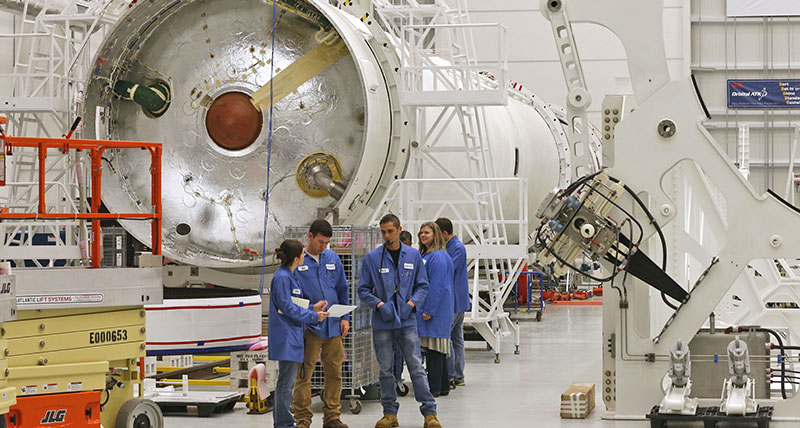
In this Dec. 17, 2015, file photo, workers look over documents in the assembly building for the Antares rockets during a tour of the Mid-Atlantic Regional Spaceport at the NASA Wallops Flight Facility on Wallops Island, Va. (AP Photo/Steve Helber, File)
The buzzword around NASA’s Wallops Flight Facility these days is “new,” as in new pipes, new concrete, new electrical systems, new plumbing and new engines.
Fourteen months after a rocket explosion derailed the facility’s signature space program, officials pronounced it ready for flight again Dec. 17.
“We’re certainly excited about the return,” said Bill Wrobel, director of the facility for NASA. “It’s been a monumental task what they’ve been through putting it together.”
The U.S. space agency and its local partners gave their first media tour of the launch area since an Antares rocket blew up in October 2014. The unmanned Antares rocket, flown by the commercial aerospace company Orbital Sciences, had been loaded with supplies intended for the International Space Station.
But it barely made it off the launchpad, exploding in a spectacular fireball seconds after liftoff. What was left of the rocket and its Cygnus payload crashed to the ground, barely missing the $120 million pad.
Dale Nash, the head of the Virginia Commercial Space Flight Authority, stood on the spot Dec. 17 where the rocket landed.
Where there had been a crater 30 feet deep and 50 feet wide, now there was only a fresh concrete pad and gravel. Here and there, pipes poked out of the ground at waist level — the wells monitoring the groundwater below for contaminants let loose by the blast.
“We replaced anything that appeared to have heat damage or blast damage,” said Nash as a gentle mist quickly gathered into a squall over the remote Eastern Shore of Virginia barrier island.
Although officials described repairs to the pad as relatively minor, they still cost $15 million — a tab split equally three ways by NASA, Orbital and the pad’s owner, Virginia Space. Major work was completed by the end of September.
A few, small tasks remain unfinished, Nash noted. The most noticeable is repainting the tank at the top of the 310-foot-tall water tower next to the pad, which still bears grayish char marks from the blast.
But the facility itself is “in great shape,” said Mike Pinkston, general manager and vice president of the Antares program for Orbital. “It’s never looked better. They’ve not only repaired all the damage from the accident but also made changes to accommodate the new engine.”
Now known as Orbital ATK, the Virginia-based company has a $1.9 billion contract with NASA to resupply the space station. It is one of three private companies competing for two contracts to continue the program through as late as 2024.
Orbital, for its part, returned to space Dec. 6 when it used a borrowed Atlas V rocket and a borrowed facility in Cape Canaveral for its third successful mission and fourth overall. It plans a second launch at the Florida facility in March.
If all goes according to plan, the contractor will perform a “hot fire” test in March atop the new Wallops pad in March and conduct its first launch there in May or June.
For now, the rocket and the huge core of the rocket are being housed inside a brightly lit hangar a few hundred yards from the launch pad.
The explosion prompted Orbital to accelerate plans already on the books to replace Antares’ AJ26 engines, which were refurbished leftovers from the Soviet Union’s 1960s-era space program. Investigators attributed the failure to a faulty turbo pump inside the motor.
The new engines are made in Russia as well. Unlike their predecessors, however, “these are brand-new, fresh-off-the-production-line engines,” Pinkston said.
Orbital doesn’t plan on conducting any test flights before its springtime launch, even though Cygnus has never been flown with the new engines. NASA’s inspector general criticized the program for that decision in a report last September.
A test flight isn’t necessary, Pinkston said, because the area where the new motors attach to the rocket are “as close to a drop and a replace as you can get,” requiring little retrofitting.
“It’s very similar,” said Dave Hastman, deputy program director for Cygnus. “The interface to us is very much the same.”
Filed Under: Aerospace + defense




